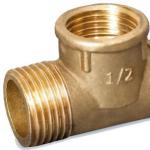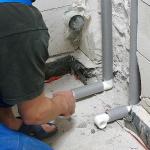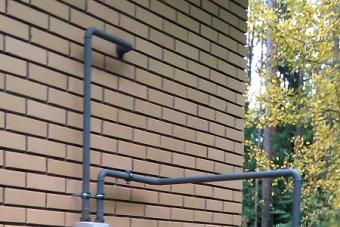If a leak is found in any place in the sewer system, then the first question that arises is how to seal the leak in the sewer pipe. We will talk about the causes of accidents and methods for eliminating leaks in this article.
Causes of accidents
In the event of an emergency, proceed to the repair of sewer pipes. Due to the fact that accidents are different, and the approach to their elimination will be different.
If the damage was caused by mechanical impact, then most likely it will be necessary to carry out a major overhaul, that is, to replace the entire pipe or its element. If the connection is simply depressurized, it will be enough to carry out minor repairs.
The causes of sewer leaks are most often associated with the occurrence of pipe defects even during their manufacture, as well as after the construction of the system - at the joints.

If a sewer pipe flows at the junction, then you will need:
- dry the joint;
- remove accumulated dirt, cement or glue;
- close the gap between the pipes with linen winding;
- generously smear with building sealant;
- wait 5 hours, after which you can start using the sewer.

If it turned out that the pipe is leaking, we will consider how to cover it up, based on their specific situation. If water oozes through a cracked mortar, then the cracks that appear after drying will need to be covered with silicone, epoxy or liquid rubber.
If fluid leaks through a crack in the pipe, then as a temporary measure, you can drive a small wooden or lead wedge into it, then wrap the damaged area with rubber or bandage and impregnate it with epoxy or install a clamp. A collar will be ideal, even if it is homemade.
Fixing cracks in sewer pipes
Due to temperature fluctuations, small longitudinal cracks can occur on cast-iron pipes.
To eliminate such a problem, first of all, on the outer part of the pipe, the crack is slightly expanded, dried and sealed with sealant. After that, the pipe is wrapped in a heat insulator.

There are times when water seeps through through cracks.
In this case, the elimination of leakage will be as follows:
- the method of cold welding with two-component glue is suitable;
- after the glue dries, we grind the seam, after which it can be painted over.
Getting rid of fistulas
Before sealing a leak in a sewer pipe, you should understand how to fix it.
You can use the first method:
- wrap the damaged area with a rubber gasket;
- tighten with clamp.

There is also an alternative method:
- if a large fistula occurs, you will need to use a repair sleeve;
- cut a piece of rubber to the size of the clutch;
- tighten well - the leak should stop.
It is worth noting that special plugs can be found on sale. They are installed in places of cleaning. You can additionally put on a rubber gasket on the plug. The solution to how to seal a cast-iron sewer pipe, if the leak continues, can be additional sealing of the plug with silicone.
If a leak has formed at the joint, then the joint on top of the sealing layer is additionally filled with liquid glass, that is, silicate glue.
Replacing a defective pipe
Often, due to serious damage, it is necessary to completely change the entire pipe. To do this, you need to stock up on tools and parts: a hacksaw, flax, pipe wrenches, a sealant, a union nut and a coupling.
The sequence of work will be as follows:
- A defective pipe section is cut out with a hacksaw, plus 30 cm.
- We unwind all the connections, clean the threads, remove the cut piece of pipe.
- We make a new thread on the old pipe. To hold it, we use plumbing keys.
- We wind the coupling onto the pipe, after which we determine the length of the pipe to be replaced, taking into account the thread.
- We fix the pipe in a vice and cut off the desired segment.
- With the help of a screw cutter, we cut a thread on it.
- We wind flax on the thread and lubricate with a sealant.
- Using a coupling, we connect a new piece of pipe to the old one.
- From the other end, we join the new and old pipe with a union nut.
If you need to repair the pipe in emergency mode, then it can be wrapped in rubber from a bicycle chamber, and then fixed with couplings.
Methods for repairing cast iron pipes
When craftsmen decide how to cover up a cast-iron sewer pipe, they have several options to choose from:
- wind strands;
- upset strands;
- use a solution of asbestos cement as a putty.
However, before starting any work, the pipe should be cleaned to a metallic sheen.

In cases where sewer pipes made of cast iron are morally and physically worn out, they are completely dismantled for replacement.
This work is done in several steps:
- with the help of a grinder, a section of the pipe is cut to the joint;
- the socket is freed from the remnants of cement and stuffing;
- the remaining section of the pipe is cut with a grinder in several places to make an emphasis on the lever;
- a crowbar is inserted into the slots and the pipe is loosened along the axis;
- the last piece of the pipe is removed from the socket;
- rubber coupling-adapter is mounted in the old socket;
- a new plastic sewer pipe is mounted in the adapter.
How to repair sewer plastic communications
Since plastic sewer pipes are quite cheap and not very reliable, it is not recommended to make a cardinal repair of the damaged surface.
In this case, the best option for cosmetic elimination of the problem would be putty with a conventional sealant.
As an additional protection, it is possible to insert fittings, for example, tees.

If a leak is found in the pipe at the junction of two segments, then you should simply replace the leaky sealing elements with new ones, not forgetting to seal the seam with silicone.
Thus, it is possible to eliminate a leak in a sewer pipe from any materials using improvised materials and tools. Use our recommendations, and you will succeed in the best way.





